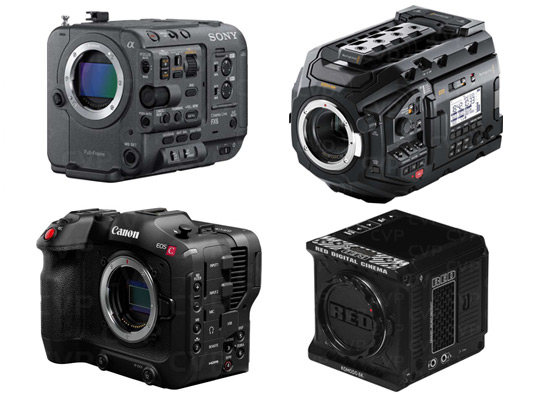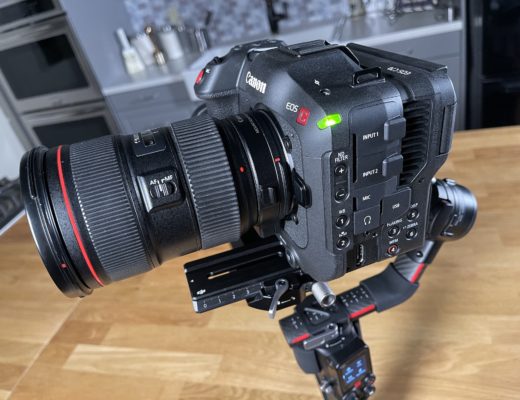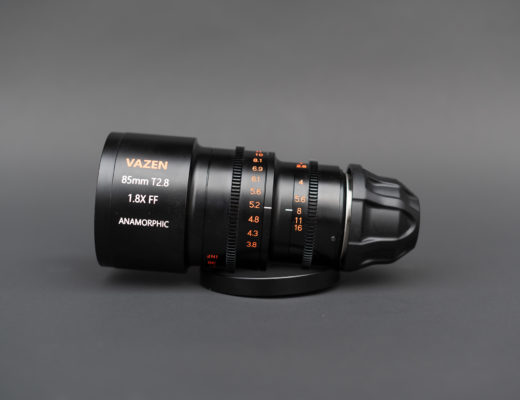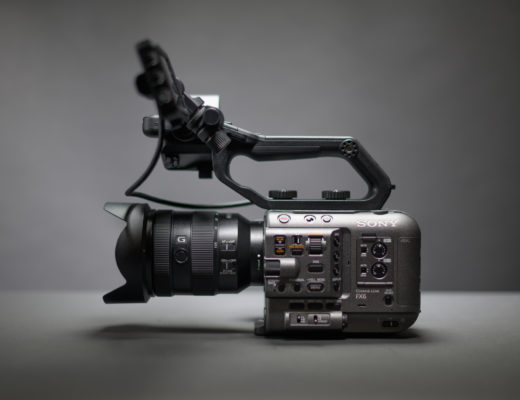Continuing on with my recent series on the best camera for video for under $4000 and under $2500, here I will look at what you get for $6000. At this price point you step up to more “professional” looking cameras with many more pro features to boot (and all of them are Netflix approved). I haven’t featured any hybrids here, though if you need one and have the budget, you can look at the Sony A1 ($6500) which shoots up to 8K30 or the Canon EOS R3 ($6000) which shoots up to 4K120.
Even though the trend these days is towards full frame, all the manufacturers at this bracket have gone with Super 35 sized sensors aside from Sony. It’s worth remembering that over the years films were mainly shot on Super 35 (or digital sensors of that size) – they just used fast and/or long lenses to get the signature look (the former reduces depth of field and the latter increases compression). It’s worth doing your research though in your market/field as to what directors and producers are asking for – both in terms of whether they care about full frame or whether they require a level above this – you might find in some documentary work for example that you need a Sony FX9 ($11,000) or Canon EOS C500 Mark II ($11,000) or possibly the C300 Mark III ($9000)- in which case it might be better to rent for a while until you can afford one.
My top tier – Sony, Blackmagic, Canon & RED
But assuming you are ready to spend $6k on a camera, here is a spreadsheet of the main contenders:

Notes:
- Pricing – is rounded to the nearest 5 to be more clear and avoid marketing
- Dynamic range & Rolling shutter – taken from the excellent lab tests at Cine D – I’m using the more realistic 2:1 signal to noise ratio figure (so it will be lower than what is quoted by the manufacturer).
- IBIS – In body image stabilization – useful for handheld shooting and vintage glass, but often only used in lower end smaller cameras
- SDI – BNC connection for SDI output (a better connector than HDMI)
- TC – Timecode – the ability to jam sync timecode from a device like a Tentacle Sync
- ND – Built in ND filters
What are the key considerations?
- Lenses – making sure your lens collection is compatible or that you are going to be investing in the right lenses. Most older lenses can be adapted to the modern mounts (e.g. Canon EF to Sony E or Canon RF), but generally EF lenses only have good continuous autofocus on either the EF or RF mount if that’s something you want to use. Newer lenses from the mirrorless ranges can’t be adapted – for example if you own Canon RF lenses you would only be looking at the C70 or the Komodo here and for people with Sony E mount lenses, they’d stick to the FX6.
- Full frame or Super 35? This is a case of pros and cons – full frame has better low light, potentially shallower depth of field (depending on the lens), but requires more expensive, larger lenses. Super 35 gives you a crop factor which you need to allow for with photography lenses. There is always the option of speedboosters for using full frame lenses on a Super 35 sensor.
- 6K or 4K? If you’re delivering 4K/UHD, it is a bonus to shoot more than that and have the leeway to crop in or stabilize, but it may not be a deal breaker for you.
- Cards/media – factor this into your budget and go through the process of what media you need for your desired codec and resolution/frame rate, I haven’t gone into detail on it here.
- Extra features? There are many other features that may or may not be important to you – I will cover key ones below and generally ignore things that all cameras have like timecode in.
In no particular order…
1. Sony FX6

I think overall Sony continues to have the most buzz in the video world and that was shown by how hard is has been to get hold of the Sony FX6 ($6000) during most of the time since launch (combined with chip shortages globally), but that seems to have settled down now. As I mentioned above, if you want full frame at this budget, this is your camera. The FX6 has the same sensor as the FX3 and A7SIII, but most agree this camera gets a bit more quality out it. It has excellent autofocus, a clever built in ND that can be automated & it outshines the others in low light capability with the full frame sensor and high usable ISOs. The increased size over the FX3 brings a more robust cooling system and a plethora of quick access buttons and dials. It can give gyro data for post stabilization which is a nice touch. Like the Canon C70, it is extremely light. The E mount brings the greater choice of lenses compared to Canon’s RF – in part due to allowing the third parties to use it (like say the Sigma range).
The FX6 does have a lower measured dynamic range than the other three cameras here. It’s also lower than the FX3/A7SIII, but that’s more to do with less baked in noise reduction which actually produces a more pleasing image. However, I don’t think that excuse can realistically be used against its competition. It is also the most limited in terms of internal codecs – the only one without internal RAW recording, should you want that. Realistically though, most aren’t going to need it. As is often the case, there were some limitations at launch that have since been updated in firmware to bring improvements.
2. Blackmagic URSA Mini Pro 4.6K G2
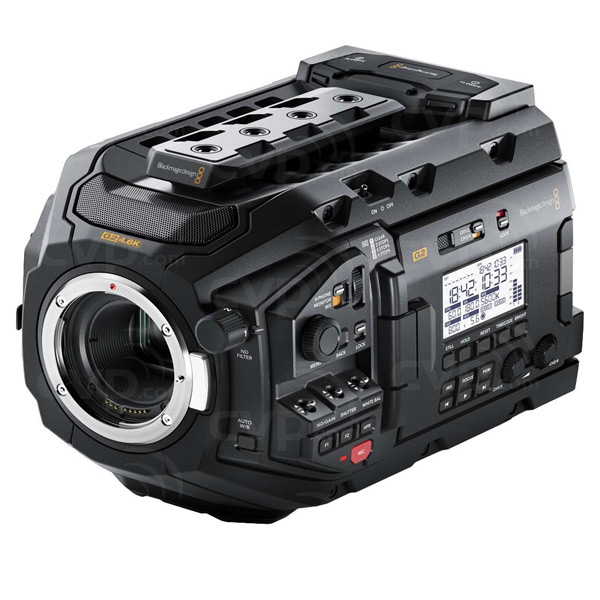
The URSA Mini Pro 4.6K G2 ($6000) – as we’ve come to expect from Blackmagic – packs a lot into this price point. For starters there’s the 4.6K – that extra 0.6 might not sound much, but that’s all you need to keep full resolution when stabilization or cropping in and delivering 4K. I’d like to see Sony & Canon considering it if they don’t want to go to 6K. Being able to shoot 4.6K at up to 120 fps (or 2K300) in BRAW- surely the easiest to use RAW codec – is excellent as is the ability to shoot straight to SSD. It also has a SDI in as well as out, making it great in a studio set up and Blackmagic have really great integration with all their hardware for multicamera setups – you can even have your live cut magically appear in the Resolve timeline. (You could also look at the cheaper URSA G2 Broadcast Camera 6K ($4200) for a studio set up or the other studio cameras). The URSA Mini Pro 4.6K G2 comes with an EF mount as standard (with optional PL, B4 and F lens mounts available separately), so it can be a great ENG camera too.
A possible downside is that it’s much heavier than the others, around the same weight as an Arri ALEXA Mini. Some DPs will mind that, some won’t, but it’s worth considering if you’re shooting all day, as is the BRAW or ProRes only recording or lack of continuous autofocus. And although the Mini Pro 4.6K was updated to the G2 version in 2021, it doesn’t quite get the same attention as it used to.
Stepping just outside this budget, you might also look at the URSA Mini Pro 12K ($6385) if you really need that extra resolution, but the dynamic range is less & there are reduced codec options (BRAW only).
3. Canon EOS C70
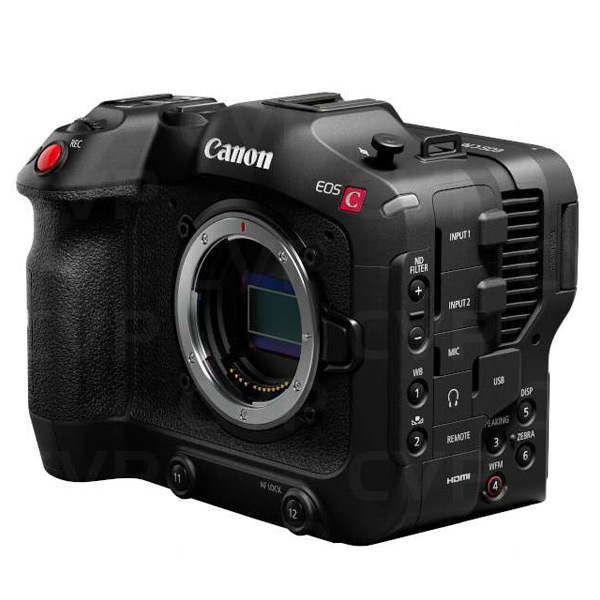
I’ve brought a fair bit of criticism to Canon at the lower price points, but things change at this price point and up. All the cameras cheaper than the C70 are hybrids and are hampered by that. The Cinema EOS team, with the freedom of making video only cameras, start to trade blows with their main rivals Sony and a case in point is the Canon EOS C70 ($5500). Its dual gain output sensor (the same as in the C300 Mark III) has the highest measured dynamic range and the footage looks great. It has good autofocus, but perhaps a little behind Sony. It has plenty of buttons, a good cooling system and a digital stabilization system designed to work in conjunction with a lens’ optical IS. It’s also a bit cheaper than the others.
Not everyone will appreciate the somewhat DSLR-esque looks of the C70 at this price, though once rigged out that may not be as noticeable and it’s an advantage for gimbal use that it’s small. It has the newer RF mount, with some great lenses, but less choice. EF lenses also adapt well to RF (in terms of continuous autofocus). It lacks SDI out (so monitors use HDMI only) and only has mini XLRs (requiring adaptors to full size). The rolling shutter is a bit worse than the FX6, but still very good. It launched with slightly limited internal recording options, but more have been added since then with firmware updates.
A big question – with the firesale of the C200 mark I – is when will the C200 mark II come out and what will they price it at? Maybe at NAB?
4. RED Komodo 6K
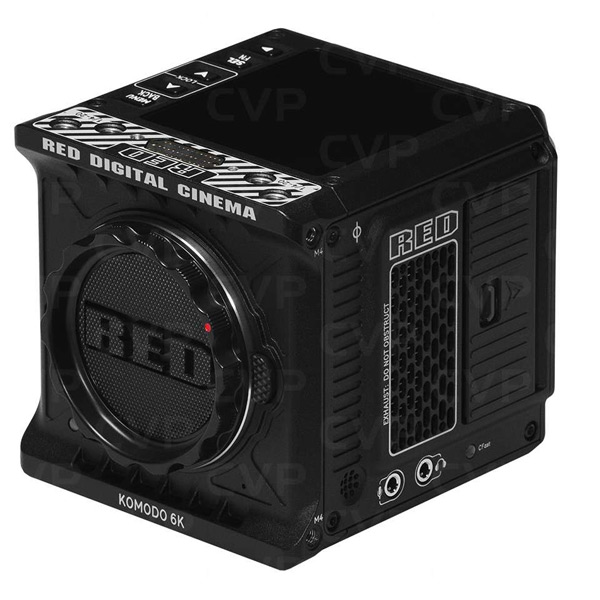
The RED Komodo 6K ($6000) is a different offering to the others, being a box camera and will cost a bit more to rig out, but I thought I’d include it here. It will generally appeal to DPs who rate the RED look above the other contenders or who want the 6K resolution. It’s amazing that it has a global shutter at this price point – giving you peace of mind that you’ll never see any jello-type artefacts no matter how you move the camera. RED also have a great phone app to control the Komodo 6K which could come in handy.
There are more limitations with the Komodo – it’s RAW or ProRes only and the high frame rates are less than the others. XLRs can be added, but only with add on adaptors. There’s no useable continuous autofocus and there are no built in NDs, in keeping with this being normally used with a matte box and separate NDs. It’s designed to be used in controlled conditions (narrative, studio, etc.), but that’s not to say doc DPs can’t use it, they might just struggle with obs-doc work unless they’re pretty experienced.
Best of the rest
Just outside this price point is the Panasonic EVA1 ($6500) which does have an impressive 5.7K of resolution. There are also some RED Komodo alternatives, like the Kinefinity MAVO mark 2 LF (from $6000) or the Z CAM E2-F8 ($6000) which are both full frame. You could also look for a second hand FS7 or C300.
I am again very impressed at the features that these manufacturers pack inside these camera bodies for the price. Long let the competition between them flourish!
